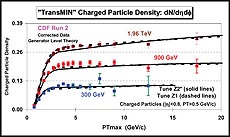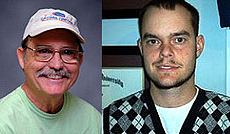The rest of the story
 |
| This plot shows CDF data at 1.96, 0.9 and 0.3 TeV on the charged-particle density in the transMIN region as defined by the leading charged particle as a function of the transverse momentum of the leading charge particle, PTmax. |
Almost all scientific publications on research at the Tevatron or the LHC focus on the physics of what happens when a postcollision particle, in particular a quark or gluon, shoots well away from the path of the incoming colliding beams. However, the collision process is complicated, and we must understand the rest of the story — what happens to the other particles that are part of the collision. We call this remaining part the underlying event.
An outgoing particle that travels considerably away from the incoming beam path is said to have a high transverse momentum or, put another way, to experience hard scattering. It is the star of the collision event, but its supporting players in the underlying event are numerous. There are the outgoing particles whose paths remain relatively close to those of the incoming beams (soft scattering). There are also the particles that accompany the hard-scattering event, not to mention the additional particles they radiate.
In this analysis, CDF scientists looked at events for which the hard-scattering particle was above a certain energy.
They compared underlying event components from three different regions of the detector, defined by where they were in relation to the hard-scattering particle: in the same part of the detector, in the opposite part of the detector and in between.
They repeated this analysis for runs from three different collision energies: 0.3, 0.9 and 1.96 TeV. The 0.3 and 0.9 TeV data were part of special runs taken near the end of the Tevatron in which beam was collided at lower energy in order to study the energy dependence of certain reactions. This analysis is the first to use the data taken at 0.3 TeV.
CDF simulated the collisions using computer programs, such as PYTHIA, that use the theory of strong interactions for the hard-scattering parts of the interaction and that could also model the soft components of the collisions. The soft-component models contain adjustable parameters; a particular set of the adjustable parameters is called a tune. Previous CDF analyses have resulted in two tunes, Z1 and Z2*. The data in the upper figure shows that the charged-particle density of the detector's in-between regions increases by a factor of 2.8 in going from 0.3 TeV to 1.96 TeV. This is just one plot of many that are studied in this analysis.
For the first time, because of the use of data at three different energies, we are able to see directly the energy behavior of the different components of the underlying energy. The occurrence of events that accompany the hard-scattering event increases exponentially relative to the center-of-mass collision energy. The radiated particles increase logarithmically.
The data presented in this analysis can be used to constrain and improve PYTHIA simulations, resulting in more precise predictions for the upcoming LHC run at 13 TeV.
—Rick Field and Andy Beretvas
Learn more
 |
| These scientists are the primary analysts for this result.
From left: Rick Field (University of Florida) and Craig Group (University of Virginia and Fermilab). |
|